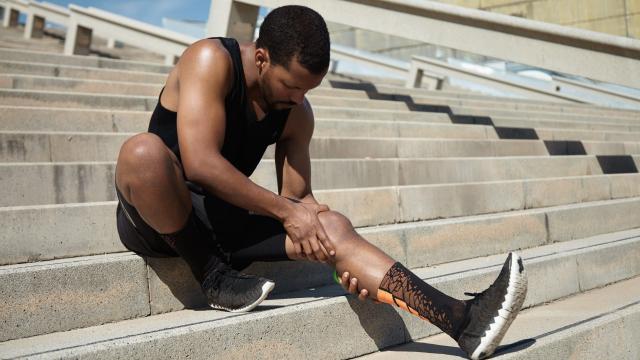Running injuries are common. So common, in fact, that an estimated 50 per cent of runners get injured every year, with some experts thinking the actual number may be even higher than that. Common injuries include stress fractures, IT band injuries, and runner’s knee. And in the past year, a lot of people have changed up their running routine — some out of necessity, and others due to increased stress or anxiety.
“I saw a huge increase in stress fractures, which is an overuse injury from high impact activity,” said Dr. Katherine Rizzone, an assistant professor of orthopaedics at the University of Rochester who specialises in treating injured runners.
In the past year, Rizzone has seen a lot of injuries, such as tendinitis and stress fractures. Given that she lives in Rochester, NY, she also saw a lot of injuries from runners slipping on the snow and ice during the early months of the lockdown, when the weather was cold and slick and the gyms were closed.
In a recent study, published in the journal Frontiers in Sports and Active Living, researchers surveyed more than 1,000 runners about their running routines before and during lockdown, as well as about any injuries they may have sustained.
Of the 10 per cent of runners who reported getting injured during the lockdown, some of the common risk factors included increasing the frequency of intense workouts, moving the location of their workouts, such as from the road to trails, having less time to exercise during the lockdowns, as well as making multiple, simultaneous changes to their workout routines.
Although this study has a number of limitations — including self-reported data and a skewed, majority-women set of respondents — the findings do line up with some of what Rizzone has seen in her runner’s clinic in the past year. As conditions changed in the last year, a lot of us have changed up our running routines.
That’s why it’s more important than ever to take a look at your overall training regimen, so as to avoid some of the common injuries that Rizzone has seen in runners during the pandemic. To avoid becoming one of Rizzone’s next patients, here are a few training strategies she recommends:
Cross-training is important
For a lot of runners, closed gyms have meant they haven’t been able to do their normal cross-training, such as swimming, cycling or the elliptical.
“Instead, they’ve now switched back to running six, seven days a week. That wasn’t smart for a lot of people,” Rizzone said.
As a result, she’s seen a lot more overuse injuries from runners who used to do regular cross-training, but shifted back to just running. To avoid developing an overuse injury, make sure you are incorporating cross-training into your routine, rather than just running all the time.
Increase intensity gradually
If you are trying to increase your training, whether it’s total mileage or intensity, it’s best to do so gradually. For mileage, the recommendation is to avoid increasing your total mileage by more than 10 per cent a week.
Rizzone’s advice is to work on increasing your total mileage and intensity at different times. For example, you could spend a couple weeks working on increasing your mileage, then a couple weeks increasing your intensity.
“If you increase amount and intensity at the same time, you really get yourself into trouble,” she said. “Increase one at a time.”
Weight-training helps
Runners are notoriously bad at incorporating weight-training into their routine. However, weight-training has a lot of benefits for runners.
“Runners do have a lower bone density than other people, and so they should be lifting for protective benefits on their bones,” Rizzone said.
Weight-training also has the benefit of increasing your overall body strength, and correcting some of the muscle imbalances that you’d get from just running all of the time. The leg muscles you get from running are a definite perk, but it’s also nice to have a strong core and some upper-body strength.
Factor in rest and recovery
The value of rest is often overlooked by runners.
“Recovery days are important,” Rizzone said. “People shouldn’t really be running six, seven days a week.”
For people who have a hard time resting, they can do relative rest, where they do another type of workout that uses a different set of muscles, such as yoga, weight-lighting, or cross-training. The important thing is to avoid overusing the same set of muscles over and over again, as that will lead to injuries.
Keep in mind other lifestyle changes
Even the runners who have kept a constant training schedule in the past year have had issues, mainly due to the changes in the rest of their lives. One culprit is that we are a lot more sedentary than we used to be, which can lead to back issues. Another surprising culprit is the fact that working from home means most people aren’t wearing shoes during the day. If you are developing foot pain, without having made significant changes to your training, you might try wearing shoes during the days.
“I saw a lot more foot pain in runners this past year,” Rizzone said. Eventually, she learned to ask if they were wearing shoes during the day. For many of them, the answer was no.
“A lot of people’s foot pain started going away when they started wearing shoes more regularly,” she said.
Injuries happen. When they do, they’re frustrating for a number of reasons, not least of which is being forced to sit on the sidelines when all you want to do is get out there again. In order to prevent injuries, it’s important to approach your training from a holistic perspective, and to remember that the goal is to safely train for the long term.

Leave a Reply
You must be logged in to post a comment.